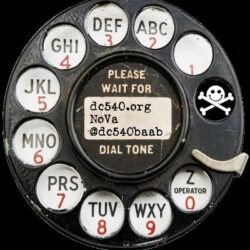Didn’t know this existed. Sounds like a great thing for potentially hostile locations, cons, etc. Take your macbook, lock all the ports, don’t worry about somebody using USBKiller or BadUSB on you.



A Virginia DEF CON community
Didn’t know this existed. Sounds like a great thing for potentially hostile locations, cons, etc. Take your macbook, lock all the ports, don’t worry about somebody using USBKiller or BadUSB on you.

Currently penciled in for January 21 (third Tuesday) since several members are unavailable during the fourth week. If you prefer another date, indicate on website or Twitter via comments.
Options include:
Original 4th Monday (27th)
3rd Monday (20th, MLK day)
some evening in between.
Several people indicated being unavailable on the fourth Monday in January. Options: 4th Monday anyway, 3rd Monday (MLK day), some other day. I’ll pencil in 4th Monday anyway until we achieve consensus.
I can safely say that I believe this show will be recognized, when the rest of the world catches up and watches it, as right up there with Breaking Bad as some of the best television ever written.
Someone on Reddit posted this, and I’m really glad I didn’t have a mouthful of coffee when I saw it. Laugh with me, fellow devotees!
I’ve been getting notices from one of my more popular WordPress sites of an increasing number of attempts to login lately. Compared to my other sites, this one feels like it’s being targeted for some reason. Normally I don’t pay a whole lot of attention to Apache logs unless I’m troubleshooting something, but I felt like ignoring this would be a missed opportunity.
The site is hosted on a shared site out in the wild. I don’t have full access to the server, but the vendor is kind enough to deposit apache logs into a known location on a regular basis.
So I spun up a Graylog instance at home, setup an automated rsync to suck down the logs, and then used filebeat with a logstash output to pipe them into Graylog for me. At some point I might set up a real SIEM (maybe SIEMonster’s community edition?) to do a bit of threat intel for me, but for now it’s a good pull this morning to have the logs for 20-30 websites sucked into my Graylog VM as a starter.
It’s a two-pot coffee day today.
The exercise ended up pulling in about 3 million log lines, and now I can easily visualize a history of what these ass-monkeys did on my hosting server.
FOLLOWUP: Yeah, turns out they were attracted to the WordPress by the unsecured Wiki hiding underneath. On 11/6, I upgraded mediawiki, and apparently missed turning off registrations. Since then, I’ve had 55,000 new users on the Wiki, and over 60,000 page edits (new pages, spam vandalism, etc). It was relatively easy to clean up after, but they were really having their way with that site.
I suspect the brute-forcing is going on especially hard today because they think nobody’s watching on a holiday weekend. BITCH I’M ALWAYS WATCHING.
Things are rolling right along for December’s meeting. I hope to see a bunch of you on the 16th.
I mentioned this on Twitter, but not all of you follow Twitter — I picked up the “Crash Course Electronics & PCB Design” course on Udemy over Black Friday weekend for just $10. I can’t say enough good things about it. I have a reasonable enough basic understanding of electronics to get by on mimicry and duplication with minor troubleshooting, but I’ve always wanted a deeper understanding and more foundational knowledge. This 100-hour course, taught patiently by Andre Lamothe, is really hitting the mark.
I guess the best way to characterize it is, come for the PCB design, stay for the best approach to electronics foundational knowledge I’ve seen yet. I was going to skip ahead to the PCB design part, but I’m learning and enjoying the electronics portion so much that I haven’t been able to pull myself away. Already I’ve added a few more things to my wishlist (a signal generator, a set of thru-hole diodes, etc.) and acquired a renewed sense of vigor and enthusiasm for my portable payphone project, which fell by the wayside in the old house when I ran into issues trying to power it properly. Exciting times indeed. It’s one thing being able to troubleshoot a circuit by trial and error. It’s another thing to understand the math and theory behind it and be able to make it right — or even make it better.
Be sure to register for the meeting so that I can be sure to have enough beer chairs for everyone.
From the Preface:
Once a novelty, drones have become standard military equipment, spawning a global network of units, bases, and test sites. Battlefields in Ukraine, Syria, and Yemen, as well as zones of geopolitical conflict such as the Persian Gulf and the East China Sea, are increasingly crowded with drones of varying size and sophistication. Whether they are used for intelligence gathering, aerial strikes, artillery spotting, or electronic warfare, drones are a leading contributor to the changing character of modern war.
The Drone Databook is a study of military drone capabilities. It is comprised of profiles of 101 countries in seven regions – Asia and Oceania, Eurasia, Europe, Latin America, the Middle East and North Africa, North America, and Sub-Saharan Africa – as well as two appendixes that address military drone infrastructure around the globe and the technical specifications of more than 170 drones currently in use by these countries. The Databook evaluates the military drone capabilities of each country in terms of six categories: inventory and active acquisition programs, personnel and training programs, infrastructure, operational experience, aircraft research and development programs, and exports.
CSD-Drone-Databook-WebMaybe you were reluctant to get on the password manager bandwagon. Passwords are inherently dangerous. Storing them in the cloud, you worry about breaches, you worry about losing access, etc. So you devised a clever pattern you thought would help you weather the storm until we finally get rid of passwords forever.
Maybe your password is a common word, then the first few letters of the site name. Long enough to avoid being guessed via brute force, and complex enough as well.
And that’s worked well for you for the past few years. You’re sitting pretty and haven’t been breached in a widespread attack.
YET.
Here’s the thing — when you use a pattern approach, every breach puts you more at risk, exposing your pattern. So far the bad actors have only been brute forcing using the breach lists (that we know of). It’s only a matter of time, if they haven’t started already, that they start cross referencing your user accounts from the various breach lists to get a per-user password list. Once that happens, inspecting those subsets for patterns will be trivial, and they will own ALL of your accounts.
Get out now, while you can. MFA where possible, long phrases if MFA is not available, 16-character complexity when long phrases don’t work.
If you don’t trust cloud password managers, use something like Keepass, but keep multiple backups in a safe place in case of corruption.
As a reminder, anyone who wants one of these should bring $15 to the December 16 meeting. You’re welcome to assemble them with the group during the meeting, or take it home and do it later. It’s a pretty easy assembly, just five wires to solder to the Wemos and the LED assembly, and then apply some code to make it do its magic.
So I happened upon an auction for a collection of HP All-In-One PCs. I’ve always thought they were great general purpose solutions for classroom, lab, specific location browser use. Not what any PC fetishist would want, but fine for group use or general use purposes.
The price was right, so I picked them up, not knowing the complete specs, with only pictures and a “tested and working” claim attached to them.
I fired the first one up during the November meeting the other night. It booted into Windows, with an enterprise login screen for a medical group — brilliant, they sold medical PCs without wiping the hard drives. Mucked around with the BIOS settings so that I could boot Ubuntu to determine the specs of the machine without opening it up, found out it had bitlocker, which didn’t like me mucking with BIOS settings.
Tried to install Kali via Fog, something was busted in my Fog installation, so I just installed Ubuntu from a USB. It turns out they have an i5 4590s quad-core in them, along with 8GB RAM and a 500GD HDD. 4x USB 3.0 ports, 2x USB 2.0 ports. Gigabit ethernet and Wifi built-in. Not too shabby, glad I picked up this auction.
So the other night, I fixed Fog (firewalld was blocking TFTP), and deployed Kali. Updated and re-captured the image so that the future builds would be more up-to-date, then imaged the second unit this morning. Imaging a new unit just takes two minutes when connected via Gig-E.
Late last night I noticed one showed a CD in the drive. Popped the tray, and what do I find but a CD, labeled by a medical services vendor, with the attached label on it.
The file on the CD was a PDF file. The file name was the patient’s full name in last, first middle format.
It took just a minute or to to create a file with every possible date for the last century, seconds to normalize the password hash so that security tools could use it, and then just seconds to run a brute force tool against the hash using the wordlist I created. Within just a few minutes of discovering the CD, I was able to view a patient’s FULL MEDICAL HISTORY.
Some lessons here:
1) DON’T leave sensitive media in PCs that are going up for auction or to be “destroyed.” Never trust that process to someone else. Remove ALL media — USB, CD, hard drives, etc. Wipe/destroy them separately.
2) DON’T put a label on something telling whoever has possession of it the exact format of a password — it really narrows things down and makes it much easier for us to “guess” it.
3) DON’T make the filename the person’s full name.
4) DON’T use DOB as a password field. It’s absolutely not complex enough. Make it a long password and hand that piece of paper to them separately, or make it available in your highly-secured medical portal.
